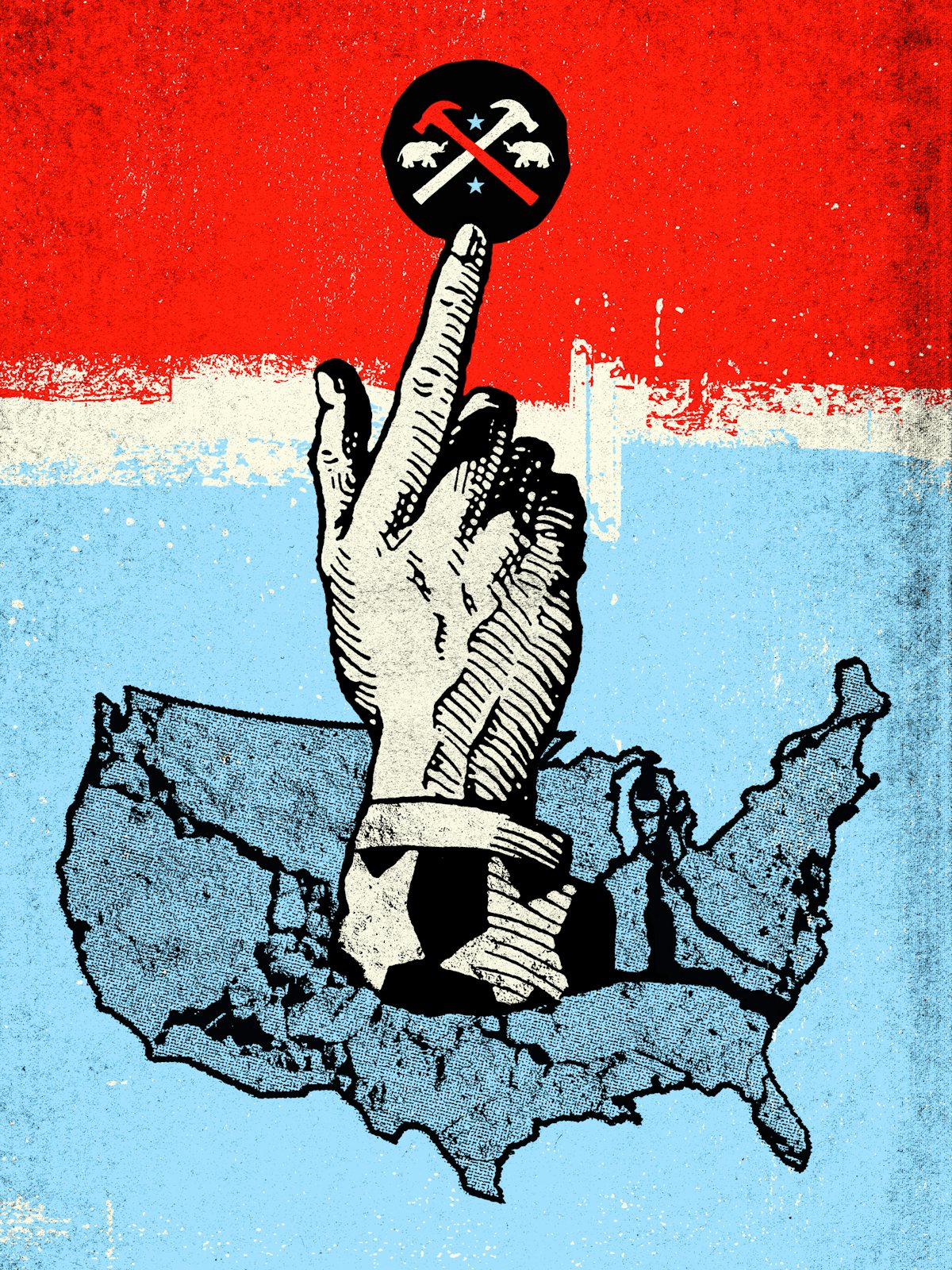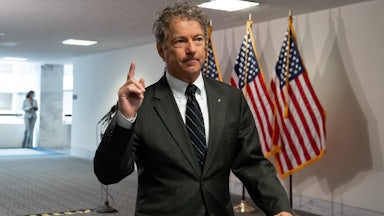“We are a working-class party now,” Missouri Republican Senator Josh Hawley tweeted at 10:53 p.m. Eastern time on election night in November. “That’s the future.” A few minutes later, Fox called Arizona for Joe Biden, beginning a string of reversals for Donald Trump and pointing toward a future quite different than the one Hawley had probably imagined when he posted. Hawley arrived in the Senate two years into the Trump era, and since then has pitched an agenda built around the concerns of the common man and woman. Sympathizing with cultural grievances, as Hawley does in fighting internet pornography, is something at which Republicans have been skilled for decades. Addressing the economic disadvantages of the less-well-off has been a blind spot. While Hawley himself has resisted mandatory increases in the minimum wage, his political world has been heating up recently, and it is changing his politics. When he announced in December that he planned to challenge the electoral-vote tally in the Senate, a rogue Walmart social media staffer attacked him as a “sore loser” via the company’s Twitter account. The company promptly apologized, but not before Hawley suggested to Walmart, “maybe you’d like to apologize for the pathetic wages you pay your workers as you drive mom and pop stores out of business.”
It took the election of Donald Trump in 2016 to show many Republicans that the left-behind were part of their constituency, maybe the most important part. With Trump’s kicking-and-screaming departure from the White House (an episode in which Hawley played a tragic supporting role), a party of upper–middle-class traditions and inclinations finds itself left alone with the working-class parts of Trump’s base, in a society where the deck is more stacked against the working class than it has been since the nineteenth century. The party’s survival depends on protecting the interests of these voters, and yet few Republicans have given much systematic thought to how they might do it. The task has fallen largely to three senators: Hawley, Marco Rubio of Florida, and Tom Cotton of Arkansas.
The Republican Party of popular imagination is a thing of the yacht club, the rotary club, and the Episcopal Church. Thomas E. Dewey, the upstanding and tidy New York governor who lost the 1944 and ’48 presidential elections, could stand as its archetype: “the little man on the wedding cake,” Clare Boothe Luce called him. But ordinary workers have been more deeply rooted in the party than is sometimes assumed. The hard-pressed “cloth-coat” Republicans who backed Richard Nixon in the 1950s and ’60s were sidelined by Ronald Reagan’s high-octane capitalism, but they didn’t disappear. In 1992, the columnist and quondam Nixon speechwriter Pat Buchanan ran a shockingly strong primary campaign. Guitar-playing Arkansas Governor Mike Huckabee in 2008, libertarian Texas Representative Ron Paul the same year, pious Pennsylvanian Rick Santorum in 2012—all of these drew from modestly situated voters recognizable as Nixon’s or, later, Trump’s.
In the twenty-first century thus far, something strange has been happening. Reaganite Republicans have continued cutting taxes to “unleash” “entrepreneurship,” but the rich people thus favored keep turning into Democrats. Loudoun County, Virginia, now the richest U.S. county, was until recently a rock-solid Republican place. George W. Bush won it by 16 points in 2000. But Barack Obama took an 8-point victory in 2008, Hillary Clinton won it by 17 in 2016, and Joe Biden won it by 24 in 2020—a 40-point shift in two decades. In the weeks leading up to December’s finance reports on the pair of Georgia Senate runoffs, the Democratic candidates, Jon Ossoff and Raphael Warnock, each raised more money than both of the Republican candidates. There are still vestiges of the old dispensation: One of the Republican candidates, Kelly Loeffler, wife of the chairman of the New York Stock Exchange, had donated $23 million of her own money. But in general Democrats now enter the political arena as the party of wealth.
They are also the party of education and prestige. On the eve of November’s election, Bloomberg News analyzed which employees gave the most to Donald Trump and which the most to Joe Biden. Biden swept the commanding heights of the economy. He got 97 percent of the contributions at Google and Facebook, 96 percent at Harvard, 91 percent at the consultants Deloitte, and (back here on planet Earth) 90 percent at the New York City Department of Education. Trump had no such near-unanimous affiliation, though he took 66 percent of contributions from the Marines, and 69 percent from the NYPD. Biden’s most loyal followers by occupation included professors (94 percent), librarians (93 percent), therapists (92 percent), and lawyers (88 percent). Trump got homemakers (96 percent), welders (84 percent), HVAC professionals (82 percent), farmers (75 percent), and custodians (59 percent). Even seeming exceptions to this class-sorting pattern prove the rule. Biden got more money from nurses and teachers, but those are professions that are being gradually up-skilled and up-credentialed, as any 18-year-old who has applied to a competitive nursing school can attest.
Last spring, Eric Levitz of New York magazine wrote a piece with a puzzle for a title: “Why Americans Don’t Vote Their Class Anymore.” He noted that, across the West in the twentieth century, “voters with low incomes and only a high-school education tended to support left-of-center parties, while high-income, highly educated voters aligned with those of the right.” Why is he so quick to insist this is no longer the case? Socioeconomic position and class interest never drift far apart for long. Traditionally, “the right,” for better and for worse, is the party of large property holdings, of bosses and managers and cultural guardians, of dominant belief systems (religious and secular), and of elite education institutions that set the boundaries of what knowledge and lore are proper to pass on to tomorrow’s generations. If America has such a party today, it is not the Republicans.
Republicans themselves have been slow to take account of this reversal. In 2008, two young thinkers, Ross Douthat and Reihan Salam, wrote a book called Grand New Party: How Republicans Can Win the Working Class and Save the American Dream. The authors warn that “Sam’s Club Republicans”—cheekily named after a Walmart-owned chain of cut-price warehouse stores where few urban Democrats had ever set foot—were losing ground. And these voters were beginning to notice that their party wasn’t doing anything for them. The old Republican entrepreneurial rhetoric of unleashing this and untrammeling that was ceasing to resonate. Worse, it now served the other party’s base.
If Grand New Party was the first call to arms in the remaking of the party, it went largely unheeded. The election of Donald Trump in 2016 was the triumph of a base that many in the Republican Party didn’t realize they had. “It feels to me like the party’s getting pushed into it,” said Julius Krein, an investor who publishes the quarterly review American Affairs, in an interview this winter. “Donors, especially, don’t want it to be a working-class party. And certainly the old guard not only doesn’t think of itself as such, but is quite hostile to that, and to any policy that could possibly lead in that direction. But it’s getting pushed there because all the elite are going to the Democrats.”
Trump’s administration worked out well for American workers, at least up until Covid hit in the spring of 2020. Unemployment was under 4 percent for most of 2018 and 2019. The good times reached even those to whom prosperity had historically been slowest to arrive. Unemployment among Black men, a whisker under 20 percent in March 2010, had fallen to around 5 percent in November 2019. According to The Economist, gains were concentrated in professions where workers had heretofore faced competition from immigrant labor, such as housekeepers and maintenance workers. The kitchen-table financial concerns of such people are, of course, no more familiar to most American opinion-formers than are the aisles of Sam’s Club. But the economic hand that Trump had to play in last fall’s elections was stronger than almost anyone outside of the working class understood, and the results—at least in terms of the swing-state popular vote—correspondingly closer.
It is an open question whether Trump’s policies had anything to do with this. Krein is certainly the most astute analyst of contemporary Republican efforts to shift economic course, especially in matters of corporate practice and public finance. But Krein doubts whether anything that could be described as Trumpism happened at all. The North American Free Trade Agreement of 1993 was renegotiated to American workers’ advantage, but that did not lead to the renaissance of manufacturing that candidate Trump had tirelessly promised in 2016. The wages of the lowest-paid workers went up, but that may be due to minimum-wage hikes enacted in dozens of states and cities.
Krein is generally skeptical of the Republican Party’s traditional economic policies. “Contrary to the pervasive mythology of entrepreneurialism and creativity,” he writes, “it is glaringly obvious to today’s professional elite that the neoliberal economy is allocating capital, and especially talent, very poorly.” Krein championed the overthrow of neoliberalism in 2016, but repudiated the president outright in the wake of Trump’s reaction to extremist violence in Charlottesville in the summer of 2017. Krein’s Boston-based American Affairs shares a number of preoccupations with the London bimonthly New Left Review. There is even overlap in some of the two magazines’ anti-capitalist writers, including Nancy Fraser and Wolfgang Streeck.
After mounting the first intraparty attack on the supply-side dogma of the Reagan years, Trump wound up strangely hospitable to its most orthodox apostles: Kevin Hassett as chair of the Council of Economic Advisers, Larry Kudlow as director of the National Economic Council, Stephen Moore as an informal tax adviser. This was not necessarily a bait and switch. Trump arrived in Washington a pariah president, virtually boycotted by communities of experts. The number of cutting-edge economic policymakers available to him was close to nil. One result was the extraordinary 2017 tax cuts, the only significant piece of domestic legislation passed in Trump’s four years. A supply-side piñata without precedent, it encouraged the corporate “buybacks” that can spur stock prices (padding executive bonuses) but can destabilize corporate finances (increasing the likelihood of layoffs in a downturn)—quite the opposite of what Trump had seemed to promise on the campaign trail. There were a few things in the tax bill that nominally helped working families, such as caps on the deductibility of corporate debt. The bill also swapped out certain tax cuts promised to corporations in order to pay for an increase in the child tax credit. But even this last, fairly modest tax benefit required a fight, including a threat from Marco Rubio to vote down the entire package if it were not included.
Rubio’s parents were Cuban immigrants to Miami. His father was a bartender. His mother was a maid. Rubio lives with his own family three blocks from his sister in the West Miami house his mother lived in until she died in 2019. “His Friday night dinner table is a blue-collar dinner table,” said a close associate. This is not the mid–twentieth-century high-wage, high-benefit industrial working-class ideal that politicians often fantasize about bringing back. Rubio’s parents’ work put them in what would be dubbed today a precarious position—without benefits, in lightly regulated industries, subject to the ups and downs of the service sector, dependent on tips and wages. Rubio seldom mentions this, perhaps because working-class life back then didn’t seem so precarious. At age 49, he is among the very youngest Americans able to remember when it was not just possible but expected that people in jobs like this would be able to own their home and raise four children.
Rubio used to tell a convoluted, policy-based story about how American economic freedom made this success possible. It was effective in helping him win Minnesota, Washington, D.C., and Puerto Rico as a presidential candidate in 2016. But it wasn’t enough to halt the progress of Donald Trump, who lumped him in with the rest of the party establishment and made short work of him in debates. Now Rubio has a simpler message: These are my people. I will fight for them. It beats the perennial Republican approach of theorizing about incentives and the capital gains tax.
Among Senate Republicans, it is Rubio who has laid the biggest bet on working people. He has a lot of ideas. He has urged fighting stock buybacks, reauthorizing Small Business Administration loan programs, and limiting Covid aid to universities with endowments of more than $10 billion. (This may give a hint of how Rubio and other working-class Republicans will enter the battle over student loan debt that is almost certain to arise early in the Biden administration. Much will depend on whom the public comes to consider the ultimate beneficiary of these loans: The indebted nurse practitioner working double shifts in an emergency room? The hipster theorist who owes $200,000 on the philosophy degree he took at Harvard? Or Harvard itself?)
The core of his agenda, said Rubio, “is the availability of good-paying jobs that allow people to raise families, to retire with dignity, to live in safe and stable communities—that’s where life is lived.” It is a more philosophically sophisticated way of talking than most Republicans are used to, but it is not far from the party’s preoccupation with “social” issues. If you care about those, you should care about inequality, which can mean the blighting of community and loss of social capital.
Josh Hawley often makes this point. Many Americans were introduced to Hawley through his interventions on behalf of Donald Trump’s attempt to nullify January’s electoral vote count. They won’t have an easy time imagining him as an innovative policymaker on issues of class. But he is one. Hawley does often sound like a throwback. He criticizes the sexual revolution, the “woke mob,” and those who propose to rechristen military bases named after Confederate generals. In this sense, his appeal to the working class is less direct than Rubio’s. He is using, in classic Reagan fashion, the correlation between working-class status and conservative cultural attitudes to win over voters without making class appeals at all.
This strategy may, indeed, explain Hawley’s recent escapades. When you get close to Republican voters, you discover one of the cultural issues they are maddest about is electoral fraud—and this has been true for a long time. Perhaps stolen elections have a symbolic, emotional resonance to people who feel power has been stolen from them piecemeal over the past half-century. Heritage Action, the activist sister organization of the Heritage Foundation, always lists election integrity among its top handful of issues. And at certain times, as in the wake of Al Franken’s besting of Norm Coleman in a convoluted Minnesota recount in 2009, it has been the number-one issue, according to one veteran conservative movement leader. In shaping his response to Trump’s claims of fraud, Hawley treaded carefully. “I’m studying what has been done in the past,” he said in mid-December, mentioning Democrats’ attempts to dispute the Electoral College result in 2004 and 2016. Had Trump’s January 6 protest not led to a storming of the Capitol, Hawley’s position on the issue may have paid off politically, forgotten by all but a grateful base.
Trumpian though he has proved, the Stanford- and Yale-educated Hawley is not especially partisan. He wants rising taxes on foreign capital inflows to benefit workers, and a falling dollar to boost exports. He works well with Democrats, and not just the old-school ones whom Republicans are most comfortable partnering up with—Gary Peters of Michigan, say, or Chris Coons of Delaware. In early December, Hawley and Bernie Sanders staggered their speeches, swapping floor time back and forth, in hopes of rallying the chamber to deliver Covid aid in $1,200 direct payments to parents. It was eyebrow-raising, Senate staffers said, because such moments require close staff coordination, and each senator pledged solidarity to the other. “I’m proud to yield the floor to him,” said Sanders of Hawley. “I’m delighted to join with Senator Sanders,” Hawley responded, adding: “Working families should be first on our to-do list, not last.”
It is not certain that Hawley will emerge from this winter’s debacle with his reputation intact. But if he manages to regain a footing on the national stage, it will likely be thanks to the legislative battles he has waged against leaders of the tech industry—who are unlikely to permit Republicans to hold a monopoly on undermining democracy for long. Here, too, Hawley has been able to work across the aisle, particularly with senators Mark Warner of Virginia and Richard Blumenthal of Connecticut. It is fair to say that tech is an obsession for him, binding together cultural issues and class issues. At hearings and online, he has laid out how Amazon crushes small businesses, Facebook spies on you, and Pornhub exploits vulnerable people in relationships. He has been a hostile questioner of Mark Zuckerberg and Jack Dorsey when they appeared before the Senate, and most of his concerns have been about content moderation and censorship. There is thus an irony that, in the wake of the Capitol riots, Hawley’s publisher, Simon & Schuster, canceled his book The Tyranny of Big Tech. The move is unlikely to dampen public interest in the book, which the Washington-based conservative publisher Regnery said it would bring out this spring.
Conservative politicians all over the world are having thoughts like Hawley’s. The French newsweekly Le Point ran a cover story in November asking: “Amazon, Google, Facebook: Are we their slaves?” It may be that the parties that fought the working class’s battles in the last century are not best equipped to fight them now. Last fall, for instance, Sanders wrote an article about the imperative of standing up to authoritarians in the future:
“Democrats must show, in word and deed, how fraudulent the Republican party is when it claims to be the party of working families,” Sanders writes. “And, in order to do that, Democrats must have the courage to take on the powerful special interests who have been at war with the working class of this country for decades. I’m talking about Wall Street, the pharmaceutical industry, the health insurance industry, the fossil fuel industry, the military industrial complex, the private prison industrial complex and many profitable corporations who continue to exploit their employees.”
Unmentioned, despite standing at the tippity-top of the American class pyramid and receiving special treatment from Congress, is the tech sector, often hostile to working-class interests and squarely in the Democratic camp. (The depth of that hostility was driven home in the successful campaign for California’s Proposition 22, which exempted “gig”-economy employers like Uber from providing collective-bargaining rights and job protections that old-economy firms are required to respect. The measure was promoted, financed, and some would say written by Big Tech and its Golden State allies.) Until recently, few congressional Democrats have been inclined to do battle with the tech companies, Alexandria Ocasio-Cortez and Elizabeth Warren being among the conspicuous exceptions.
Tom Cotton, a Harvard-educated Republican lawyer from tiny Yell County, Arkansas, is trying to use China the way Hawley uses Big Tech. Cotton’s hawkish position on trade precedes the rise of Trump, but as China’s depredations have grown, they have given him ways to touch a surprising number of concerns in his state. Arkansas’s missionaries are troubled by the suppression of Christianity, grad students in Fayetteville are troubled by the repression of pro-democracy protests in Hong Kong, and the state’s farmers are worried about intellectual property theft of rice genomes. Cotton has been the guiding spirit behind the bipartisan American Foundries Act, which seeks to bring semiconductor manufacturing supply chains back to the United States, on both national security and industrial policy grounds. One assumes that fighting this fight takes a certain amount of finesse on Cotton’s part, since China-dependent Walmart, the nation’s largest employer, is headquartered in Bentonville.
When the public compares the two parties on the question of protecting the working class, it is still Democrats who come out on top—but not by a lot. Asked by The Hill newspaper, 46 percent said the Democratic Party “fights more” for workers, versus 36 for Republicans. Even as Republicans seek to change that perception, they seem uneasy when comparisons are drawn between their policies and Democrats’.
“With the debate in the party, you’d think I was proposing a Bolshevik-style revolution or something,” Rubio said in January about his buyback policy. “I’m not talking Elizabeth Warren buyback policies where I want to punish corporations or ban them. All I’m saying is, if you do a share buyback it should be treated the same as you would dividends.”
Similarly, Cotton defends his working-class policy orientation as something that departs in an important cultural way from that of his Democratic rivals. “People like Bernie Sanders tend to view working-class jobs as Dickensian hellholes from which all anyone would want to do is escape,” he said just before Christmas. The Democratic attitude, in his view, is: “Why would anyone want to work on a construction site or be a plumber or a welder or an HVAC repairman? Why would anyone want to drive a truck? Obviously, the solution is to give everyone free college tuition and get them out of these Dickensian nightmares so they can become an HR diversity consultant or some other white-collar desk job.”
There is a philosophical disagreement about how one gives the working class more power. To boil it down to the basics, Democrats believe in more unions and Republicans believe in less immigration.
The most closely attended-to conservative voice on this issue is Oren Cass, a former Mitt Romney adviser who heads American Compass, a conservative think tank that calls for “widely shared economic development.” Nearly all the Republicans loosely aligning themselves with working-class interests listen to Cass, and it’s partly because he has a theory about the economic history of this century and how it led to our present predicament.
“It would be a mistake to look at Trump as the future of conservatism,” Cass said in December. “Trump is obviously not conservative under any definition of the term. He’s essentially an earthquake.... On the one hand, that’s costly and dangerous. On the other hand, it has the benefit of showing what the weak structures were, and where the foundations had eroded.”
As Cass sees it, the weakness of structures has been explained by the work of M.I.T. economist David Autor, who has given us a new understanding of how labor markets work under globalization. A “China shock” wiped out a good deal of manufacturing employment after China’s accession to the World Trade Organization in 2001, Autor has shown. “Skill-biased technical change” drove college-educated workers’ compensation up and that of the noncollege-educated down. The economists Anne Case and Angus Deaton gathered similar evidence of the collapse of labor markets and the rise of regional inequality in their 2020 book on opioids, suicide, and life expectancy, Deaths of Despair and the Future of Capitalism.
Such processes take time to figure out. Cass believes that we can now see these misfortunes as the chickens of the late twentieth century coming home to roost. Cass is a friend of the memoirist J.D. Vance, author of Hillbilly Elegy, a book that is often read as an X-ray of how eastern Ohio and other parts of Appalachia were struggling as Hillary Clinton and Donald Trump were vying for the presidency in 2016. But Cass reminds us that the embrace of this coming-of-age saga as an all-purpose explanation of Trump’s new pitch to the working class was misguided, for Vance was already in his thirties when it was published. “The story that he is telling,” Cass insisted, “is of what was going on in the late ’90s, during what we think of as the go-go years, the boom years, the very best years.”
Indeed, an interesting general question arises to challenge Republicans about the 1980s and 1990s—were the policies arrived at outright wrong? Or were they fine policies for their time that were just maintained for too long? “If you talked to Republicans and gave them truth serum,” one congressional political adviser admitted, “a majority would say we had it wrong for decades on immigration and trade. We were too quick to look just at the lower price of goods and how that ultimately helped people, and didn’t spend enough time looking at people who were directly hurt by factories being closed and lower wages.”
Cass’s central insight is: Tight labor markets are good. That is how unions work to drive up wages, and if conservatives want higher wages, they will need to overcome their “foolish orthodoxy” on the matter. At the same time, you can’t believe unions are good and say any amount of immigration is fine. Limiting immigration raises wages—which is a key reason that the postwar labor movement supported immigration restrictions. After Arizona cracked down on immigration in 2010, construction and farm wages rose 10 to 15 percent. From a supply-and-demand perspective, mass immigration does the same thing as offshoring and de-unionizing: It exposes workers with American labor protections and lifestyle expectations to competition from workers without them.
Assuming the rumbling Trumpian earthquake within the GOP settles, and assuming the party is able to avoid a factional split, Republicans’ rapport with the working class may turn out to be more natural than it now appears. They won’t have to “come up with” policies for helping the workers, still less to “reinvent” themselves as a working-class party. More likely, they will follow the logic of the situation to embrace the sort of policies Democrats followed when they were the party of the workers and the Republicans the party of the bosses.








